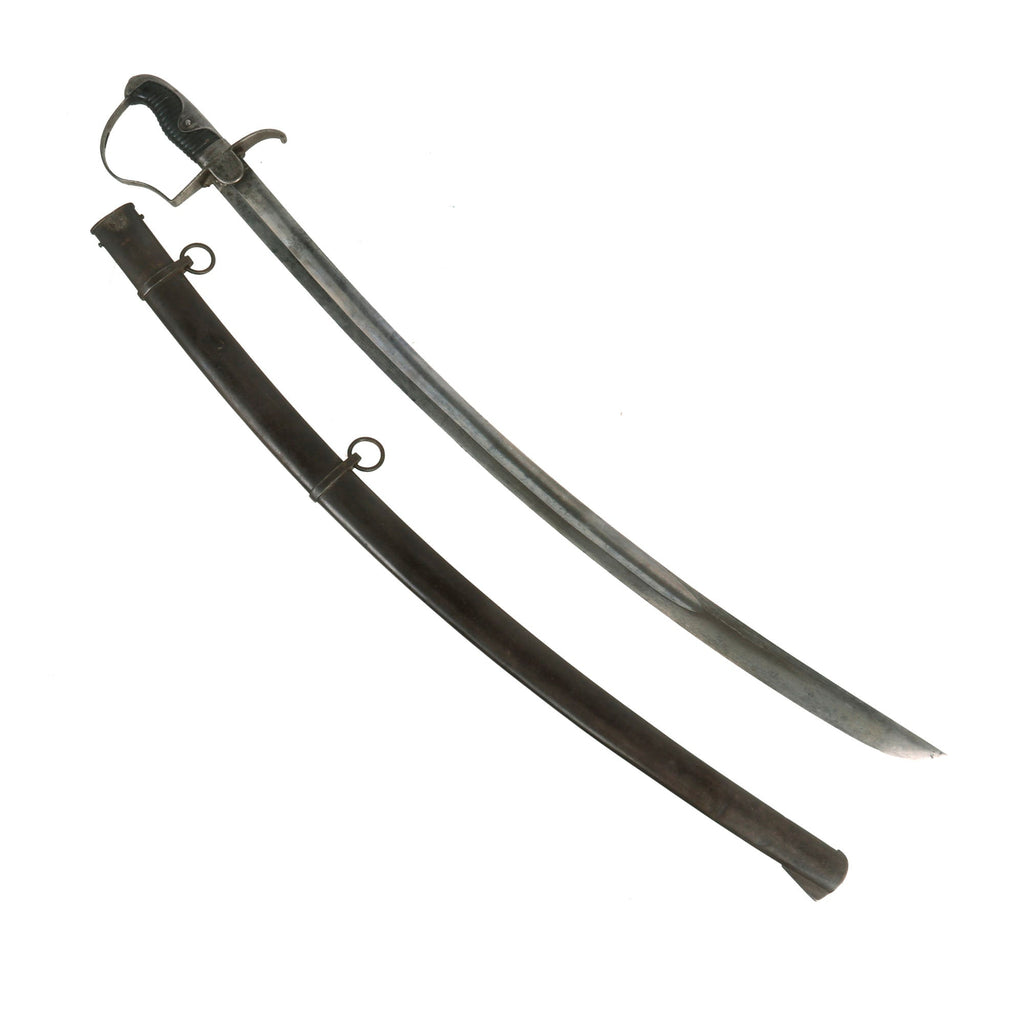Item Description
Original Item: Only One Available. This is a beautiful specimen of the British P-1796 Light Dragoon Saber. The Pattern 1796 light cavalry saber was primarily used by British light dragoons, hussars, and King's German Legion light cavalry during the Napoleonic Wars. It was also adopted by the Prussians (known as the 1811 pattern or "Blücher saber") and utilized by Portuguese and Spanish cavalry.
We have a remarkable item that was once a true work of art. Although it is now showing signs of wear, it is still a testament to the skill of its creators. Fortunately, it retains nearly all of its leather-wrapped wooden grip, leaving only a few traces of open wear. However, the "stirrup" steel guard and the original heavy iron Scabbard still remain, adding to its beauty and historical significance.
This item boasts a curved hatchet point blade that measures approximately 32 1/2” X 1 1/2". With an overall approximate length of 37 ½”, it is a sizable piece that would have been an impressive sight in its time. Although the spine of the blade has no visible markings, it is clear that this item was crafted with care and attention to detail.
The scabbard is also a thing of beauty. Although it has very little paint left, it is still a sight to behold. There is some minor staining and pitting present, but these imperfections add to its character and history. Overall, this item is a solid example of the craftsmanship of its time.
A fine sword and scabbard ready for display.
Dimensions:
Blade length: 32 1/2”
Overall length: 37 1/2”
Handguard: 5”L x 6”W
Scabbard length: 33 1/2”
During the early part of the French Revolutionary Wars, the British Army launched an expeditionary force into Flanders. With the invading army was a young captain of the 2nd Dragoon Guards, serving as a brigade major, John Gaspard Le Marchant. Le Marchant noted the lack of professional skill displayed by the horsemen and the clumsy design of the heavy, over-long swords then in use (the 1788 Patterns) and decided to do something about it.
Among many other things Le Marchant did to improve the cavalry, he designed, in collaboration with the Birmingham sword cutler Henry Osborn, a new saber. This was adopted by the British Army as the Pattern 1796 Light Cavalry Sabre. Le Marchant wanted his saber to be adopted by all British cavalry, but the board of general officers decided to arm the heavy cavalry with a straight sword.
An eastern influence can be detected in the blade form, and Le Marchant is recorded as saying that the "blades of the Turks, Mamalukes, Moors and Hungarians [were] preferable to any other". The blade profile is similar to some examples of the Indian tulwar, and expert opinion has commented upon this. This similarity prompted some Indian armorers to re-hilt old 1796 pattern blades as tulwars later in the 19th century.
The 1796 sabre had a pronounced curve, making the kind of slashing attacks used in cavalry actions decidedly easier. Even cavalrymen trained to use the thrust, as the French were, in the confusion of a melee often reverted to instinctive hacking, which the 1796 accommodated. Its blade, unlike other European sabres of the period, widened near the point. This affected balance, but made slashes far more brutal; its action in the cut has been compared to a modern bacon slicer. It is said that this vicious design prompted unofficial complaints from French officers, but this is unconfirmed. The blade of the light cavalry sabre was from 32.5 to 33 inches (83 to 84 cm) in length and had a single broad fuller on each side. The sabre was lighter and easier to use than its heavy cavalry counterpart, the pattern 1796 Heavy Cavalry Sword, which had a less 'scientific' design. The hilt was of the simple 'stirrup' form with a single iron knucklebow and quillon, so as to be free of unnecessary weight; the intention of this was to make the sabre usable by all cavalrymen, not solely the largest and strongest. A typical trooper's sabre would be close to 2 lb 2oz (0.96 kg) in weight. In common with the contemporary heavy cavalry sword, the iron backpiece of the grip had ears which were riveted through the tang of the blade to give the hilt and blade a very secure connection. The grip was of ridged wood covered in leather. It was carried in an iron scabbard, with wooden liners, and hung from the waist via sword-belt slings attached to two loose suspension rings.
- This product is available for international shipping.
- Eligible for all payments - Visa, Mastercard, Discover, AMEX, Paypal & Sezzle













